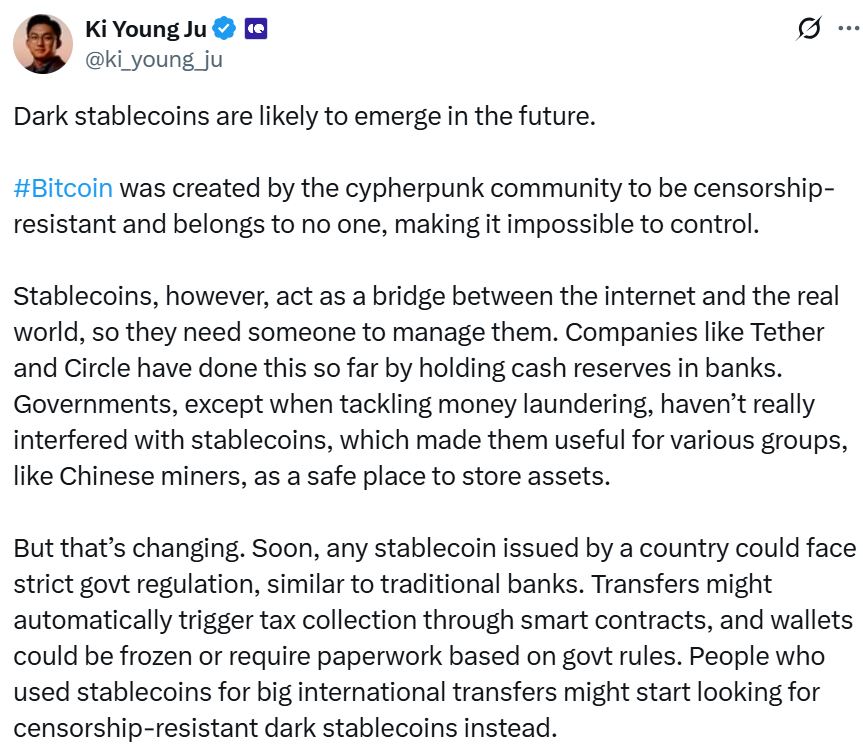The Emergence of Dark Stablecoins
As governments worldwide increase their scrutiny and regulation of stablecoins, a new breed of digital asset is gaining traction: dark stablecoins. These cryptocurrencies aim to offer censorship resistance and privacy, potentially appealing to users seeking autonomy in their financial transactions.
Ki Young Ju, CEO of CryptoQuant, suggests that stricter regulations on government-issued stablecoins, similar to traditional banks, could drive the demand for these dark stablecoins. He anticipates that standard stablecoin transfers might face automated tax collection and potential wallet freezes based on government rules. Consequently, individuals and entities engaging in large international transfers may turn to dark stablecoins as an alternative.
“People who used stablecoins for big international transfers might start looking for censorship-resistant dark stablecoins instead.”
The regulatory landscape is evolving rapidly. In the United States, lawmakers are considering stablecoin legislation to ensure their legal use for payments. Meanwhile, the European Union has already implemented its Markets in Crypto-Assets (MiCA) regulation, which mandates the regulation and transparency of stablecoins.

What are Dark Stablecoins?
Dark stablecoins are cryptocurrencies designed to maintain a stable value while providing enhanced privacy and censorship resistance. They achieve this through various mechanisms:
- Algorithmic Mechanisms: These stablecoins maintain their value through algorithms rather than being pegged to external assets. This makes them potentially less susceptible to interference from authorities. For example, a decentralized stablecoin might track the price of regulated coins like USDC using data oracles such as Chainlink.
- Issuance by Uncensoring Countries: Stablecoins could be issued by countries with less stringent financial transaction censorship policies.
- Non-Compliance: In some cases, existing stablecoin issuers might choose not to comply with regulations. As Ki Young Ju points out, USDT once possessed censorship resistance. Should Tether opt out of US regulations under a future Trump administration, it could transition into a dark stablecoin.
Privacy Technologies in Crypto
While not stablecoins themselves, cryptocurrencies like Zcash (ZEC) and Monero (XMR) already employ privacy-enhancing technologies. They shield transaction details, allowing users to send and receive funds without exposing their transaction data on the blockchain.
Several projects are exploring the use of similar technologies for stablecoins. Zephyr Protocol, a Monero fork, hides transactions, while PARScoin conceals user identities, transaction values, and links to past transactions.
The Growing Stablecoin Market
The market capitalization of US dollar-denominated stablecoins has experienced significant growth, surpassing $230 billion in April. This represents a 54% increase since the previous year. Tether (USDT) and USDC dominate the market, accounting for approximately 90% of the total market share.
Furthermore, total stablecoin volumes reached $27.6 trillion in 2024, exceeding the combined volumes of Visa and Mastercard by 7.7%. This underscores the increasing adoption and utilization of stablecoins in the global financial system.
Key Takeaways:
- Regulatory Pressure: Increased government regulation of stablecoins could fuel the demand for censorship-resistant alternatives.
- Privacy Focus: Dark stablecoins prioritize user privacy and autonomy through various technological and operational strategies.
- Market Growth: The stablecoin market continues to expand, indicating a growing need for digital assets that offer stability and flexibility.
The emergence of dark stablecoins reflects a broader trend in the cryptocurrency space towards privacy and decentralization. As regulations evolve, these digital assets may play an increasingly important role in the future of finance, offering users greater control over their financial transactions.